Somewhere in the early ‘80s my mother bought me Quintillions as a Christmas present. She did so at a craft show, buying it from Kate Jones, the creative mind and driving force behind Kadon Games and the GamePuzzles website*. My puzzle and gaming mind was immediately hooked.
“You’d love her booth,” my mother said. “It’s nothing but puzzles and games.”
A year or so later I found Jones at the Maryland Renaissance Faire. (This was before she built her permanent RennFaire building.) I spent so much time at her booth I seriously annoyed the people I’d gone to the Faire with. So many games. So many puzzles.
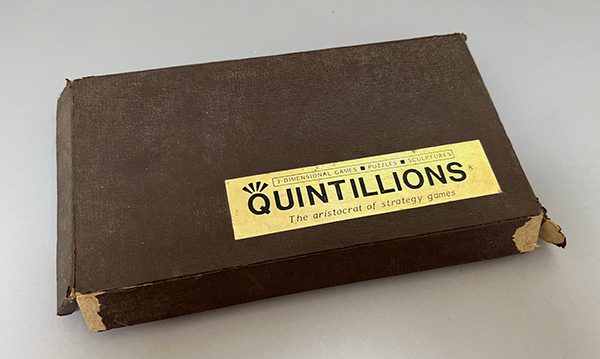
Years later, when my wife and I started doing craft shows, I ran into Jones again. Quintillions was still on the table, as well as some puzzles I recognized. What impressed me the most, however, was that there were so many new and different puzzles and games on display. She never stopped dreaming up new challenges.
Waitaminite…Didn’t You Already Write About Pentominoes?
Astute readers will be quick to point out that I have already reviewed a game that made use of pentominoes. That was Katamino, a collection of colorful pentominoes set within a 5×12 frame. While a single game was mentioned in the rule book, Katamino is really more of a 2D puzzle, with challenges consisting of creating a rectangle of a given size with given pieces.
What makes Quintillions different and why do I think it’s by far the better choice?
Components
The pentominoes in Quintillions are made of laser cut, polished hardwood. My set is 40 years old and it still looks as good as the day I opened it up. They feel good in my hand and fit together extremely well. This is a polished set of pentominoes, and not just in the tung oil/woodworking sense of the word.
The bright colors of Katamino might appeal to kids, and that’s fine. However, I found that trying to work out the puzzles in Quintillions (see below) with multi-colored pieces was annoyingly distracting. Quintillions pentominoes are simply a more sophisticated choice.
More Elaborate Puzzles
For the hundreds of puzzles listed in the Katamino booklet, they are all restricted to solid rectangles within the 5×12 frame. While this helps to provide a structure for the mental activity required to solve each one, it is an unnecessarily restrictive structure.
The puzzles in the 80-page Quintillions booklet start with rectangles of varying sizes, but quickly leaves that shape behind for others. There are, for instance, two different designs for each letter of the alphabet. There are rectangles of varying sizes with ‘holes’ of different sizes in various locations
Rectangles too boring? Not a problem. How about a heart?
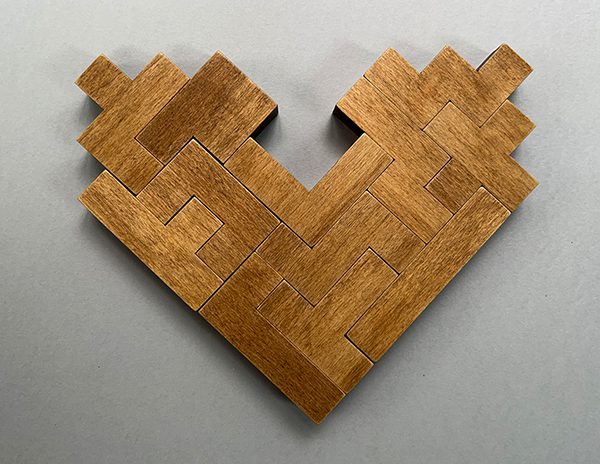
One of my favorites is the way the pentominoes can be arranged to create the shapes of each of the pentominoes themselves.
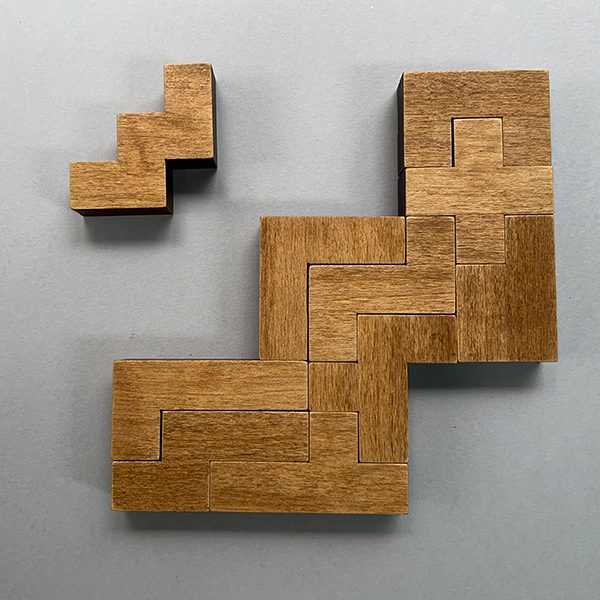
3D Puzzles
All those many years ago I dove deep into the 3D puzzles listed in the Quintillions booklet. Many of these reminded me of shapes I had worked on with the Soma cube I had as a kid—but those pieces had three 3D pieces and the pentominoes are only 2D shapes.
Jones starts you off with smaller shapes to get your brain thinking in three dimensions.
For instance, here’s a deceptively simple shape. The front is clear, but what two pieces create the back?
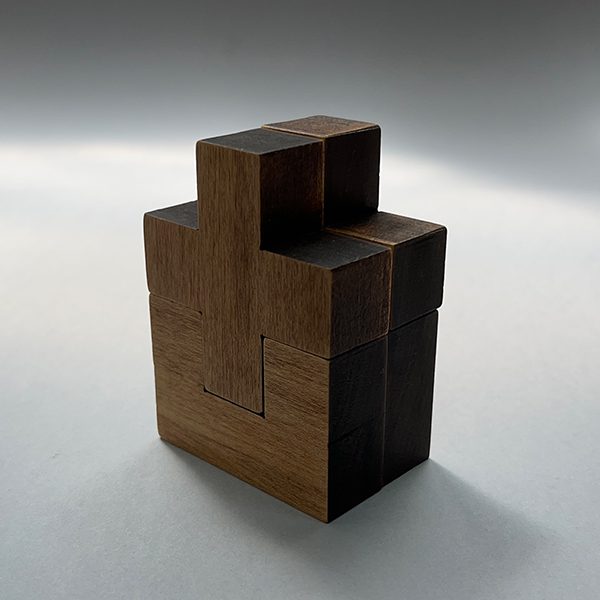
And here is one of many small towers that can be built.

The puzzles become more elaborate, expanding the way you think about the shapes and the way they interconnect with one another.
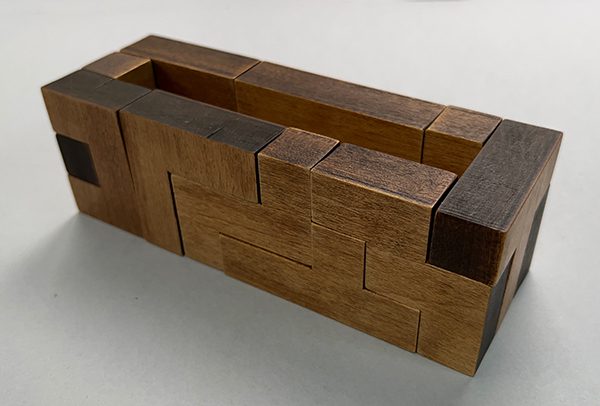
Some have empty spaces, some are solids.

And Yes, Challenging Games
In my review of Katamino (like my review of MazeScape before it) I asked, “but is it a game?”
With Quintillions, the answer is a solid Yes. Each of the games included in the booklet (and their variants) are easy to teach and create challenging, interesting decisions on each turn.
The game’s namesake has players placing pieces flat on the table in such a way to maximize the number of contact points between the pieces. (Each ‘square’ of contact equals one point.) After all the pieces have been placed, pieces are moved from one spot on the board to another, with contact points scoring in the same manner. After an agreed upon number of turns, players then remove pieces, scoring for each contact point removed.
Back in the day, a good friend of mine and I played Quintillions once a week. Games were always tight, with scores typically only separated by only a few, scant points.
Then we moved on to the 3D version of Quintillions. Here, the pieces can not only be arranged flat on the table, but atop each other. (This can be played to an agreed upon stacked level.) This game necessitated clearing off the kitchen lazy susan to allow us to turn the game from side to side to determine our optimal next move.
With Quintominoes, you follow the same rules as Quintillions, with the restriction that each new piece must make contact with the last piece placed.
In Squint, you place pieces onto the included 9×12 vinyl board. Each new piece must touch the corner of another piece on the board (similar to Blokus). Players may decide before playing whether the winner or the loser is the last person who can place a piece in a legal position on the board.
Blockout has players agreeing on the dimensions of a 3D rectangle (e.g., 2x5x7 or 3x3x7, or the above 3x4x5), then placing pieces onto the board such that they do not extend past those boundaries. The last player to legally add a piece is the winner.
Thoughts
It comes down to this: I’ve kept my copy of Quintillions for over four decades for a reason. It combines a well-made, challenging puzzle with a set of games that I still enjoy to this day. The condition of the box (above) is a testament to how much I like the game and how long and far it has traveled with me.
The afternoon I spent working out the 3D puzzles for the photos for this review was both frustrating (How have I forgotten how to do this?) and extremely rewarding when I did get the puzzle solved. I’ve already pulled them out more than once to go back to some of the more complex shapes
And if I could sit down across the table from my old friend David, I’d pull out Quintillions in a heartbeat. (Along with a lazy susan.)
How many games can you say that about?
_______________________________________
* Full Disclosure: On the GamePuzzles website, you’ll find my name listed. In the mid-90s, when websites were new and Jones hand-coded all the HTML for her site, I was the person who convinced her to “abundantly hyperlink” her pages to one another.



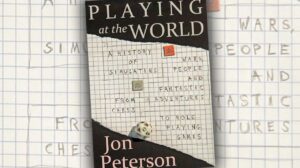
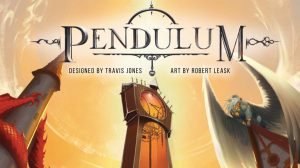
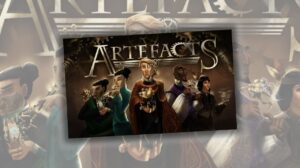
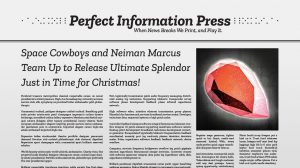




Add Comment